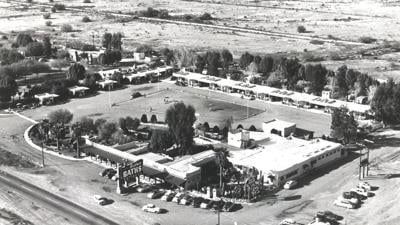Mesans have been waiting over a decade to find out the long-term fate of the historic Buckhorn Baths spa buildings near Main Street and Recker Road since the passing of Alice Sliger in 2010.
Sliger created the storied Buckhorn Mineral Wells and Wildlife Museum in East Mesa with her husband Ted Sliger, who died in 1987.
But residents and history buffs may be waiting a while longer to find out if the old buildings will be saved amid disagreements between the current owner, Aktar Verma of Paradise Valley and Mesa city planners.
Verma has expressed an intention to preserve Buckhorn’s historic buildings, which sit within a larger 11-acre parcel of mostly vacant land that he wants to turn into multifamily housing.
Developers for Verma and city planners are at odds over what the housing complex adjacent to Buckhorn should look like.
The owner is focused on getting the apartments built and generating revenue; plans for the historic structures’ ultimate use are still hazy.
The city doesn’t oppose apartments on the site, but it isn’t sold on the current designs and its relationship with the historic section of the property.
An October meeting about the latest plans became tense as representatives for Verma dangled the possibility of removing the site’s historic landmark status and redeveloping the parcel according to current zoning – without regard to the historic structures on the site.
“As we know, the previous owner was planning to flatten the entire site and put a trailer park there. Thank goodness that didn’t happen,” said Tim Boyle, the architect who is working with the owner on redevelopment plans.
“The current owner, if he gets frustrated enough, is just going to be like, ‘OK, let’s just take this out of (the) historical preservation,’” Boyle continued.
When a planner reminded him that the parcel has a Historic Landmark overlay on it, Boyle replied, “It takes about six months and you can remove (that).”
Verma’s attorney, Ralph Pew, did not respond to requests for comment last week about the project’s current status or discussions with the city.
Mesa Senior Planner Cassidy Welch told the Tribune, “City Planning staff continues to work with the applicant on this project.”
Boyle and Pew were frustrated in the meeting because city planners were withholding support for the project until certain conditions are met.
City planners want Verma’s proposed 210-unit complex to be more in harmony with the historic portion of the site.
Another is the city wants some movement on preservation of the historic structures in the early phases of the project, and they want these steps outlined in a development agreement.
The city’s fears that developing the housing completely separate from the historic spa facilities and casitas would not be attractive, and worse, potentially leave the historic buildings to decay beyond recovery.
Local historian Mesa Preservation Foundation President Vic Linoff is particularly concerned about a long delay in restoration, saying that Buckhorn Baths are in danger of “demolition by neglect.”
The buildings “are really deteriorating,” he said, and need stabilization soon.
But renovations of the structures will likely be costly and a possible recession looms.
Representatives for Verma said they need to get the housing component of the project built first in order to generate revenue to fund preservation of the historic buildings.
They are frustrated with the city’s demands and resulting delays.
“Why can’t we approach it and say, ‘OK, Mr. Verma, thank you for preserving the Buckhorn,” attorney Ralph Pew said during the discussion. “I just would wish that as a city, we would think of the fact that right now, he’s not obligated to do any of that.”
At one point Boyle lost his temper and seems to have slammed his fist on the table based on the recording.
“I think at this point the conversation has ended,” Welch said a short time later. “I don’t feel comfortable moving forward at this point.”
During the meeting, Welch described the Buckhorn Baths site as “one of the most iconic and significant sites in the city.”
The lore of the Buckhorn Baths includes the Sligers’ chance discovery of hot mineral water while drilling a drinking water well in 1939.
The water came up 127 degrees and subsequent testing showed good mineral composition for soaking.
The Sligers then developed their gas station and taxidermy museum into a spa and hotel.
It became a part of Mesa’s important roadside history and helped entice Major League Baseball owners to bring their players to Mesa for Spring Training, Linoff said.
The Sligers filled the spa with sports memorabilia, artifacts, art and taxidermy by Ted.
The Buckhorn Baths was an early adopter of neon in Mesa, and the property includes a stylish mid-century neon sign that “stops traffic” on Main Street the rare times it’s turned on due to its dazzling qualities, Linoff said.
The spa hosted sports legends and the Sligers organized large barbecues on the property that would attract thousands when Mesa was still a small town.
At one point, “anybody who was anybody” stayed at the bath, Linoff said.
In 2012, Mesa voters approved bond dollars for the city to purchase the site, but the city was not able to reach a deal with the heirs and the property passed to other buyers.
Linoff hopes the buildings are saved.
“How the Buckhorn was built is unique. Ted didn’t use any architects,” he said. “He did everything on the cheap, but built a remarkable place out of nothing but scrub bush and sand.”

